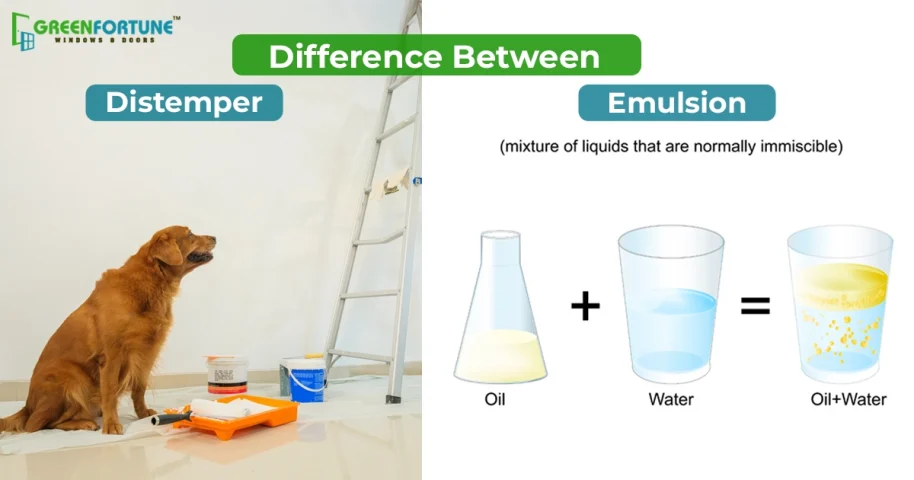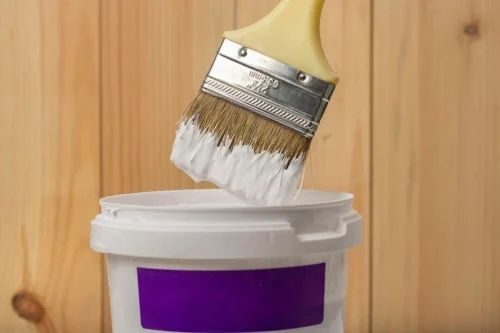
How Solar Exposure and Local Microclimate Influence Your Exterior Wall Colour Choices
April 9, 2025
Understanding Real Estate Measurements: Carpet Area vs Built-Up Area
April 9, 2025When it comes to painting your walls, one of the first decisions you'll face is distemper vs emulsion paint. To choose the best paint, you need to understand the difference between distemper and emulsion before making your choice. Depending on factors like climate, lifestyle, and budget, it’s essential to weigh the pros and cons of each option carefully.
Today, people look for finishes that reflect their personal style and also offer long-term durability. But ultimately, the decision comes down to balancing your budget, the amount of maintenance you're willing to invest in, and the specific conditions of the space you're painting.This blog will break down these factors and provide a clear comparison of distemper vs. emulsion paint so you can make the best choice for your needs.
Table of contents
- What is Distemper Paint?
- Features of Distemper Paint
- What is Emulsion Paint?
- Features of Emulsion Paint
- Difference Between Distemper and Emulsion Paint
- Pros and Cons of Distemper vs. Emulsion Paint
- How to Decide Between Distemper vs Emulsion Paint for Your Project
- Distemper vs Emulsion: Which is the Better Choice?
What is Distemper Paint?
To make the right choice between distemper vs. emulsion, start with the basics. Distemper is one of the oldest types of paint used for walls. It’s also known as whitewash paint and is made from a mixture of chalk, pigments, and a binder like lime or glue. Although it’s affordable, distemper paint differs in many aspects from the more modern emulsion paints.
There are different types of distemper paint available:
- Dry Distemper (Powder-Based): This comes in powdered form and is mixed with water before applying. It's budget-friendly but doesn’t last as long.
- Oil-Based Distemper: This uses oil as a binder, which makes it a bit more durable than dry distemper but still not as strong as emulsion.
- Acrylic Distemper: This variant has acrylic resins that make it stick better and last longer than traditional distemper.
Features of Distemper Paint
- Affordable: Distemper is cheaper than emulsion, so it’s a good choice for those on a budget.
- Matte Finish: It gives a soft, chalky texture, which suits a rustic look.
- Not Water-Resistant: Distemper absorbs moisture, which can lead to peeling and fading over time.
- Low Washability: It’s not easy to clean. Scrubbing may remove the paint.
What is Emulsion Paint?
On the other hand, emulsion paint is a more modern, water-based paint. It’s made with synthetic resins, such as acrylic or vinyl, which give it a smooth, durable finish. In the debate of distemper vs emulsion, emulsion paint stands out for its superior resistance to wear and tear. It is an ideal choice for high-traffic areas and homes that need long-lasting results.
Emulsion paints also come in different types:
- Matte Emulsion: This finish is non-reflective and perfect for covering imperfections on the walls.
- Silk and Satin Emulsion: These give a soft, shiny finish that looks elegant and is easy to clean.
- Glossy Emulsion: This paint is ideal for areas with high moisture, like kitchens and bathrooms.
Features of Emulsion Paint
- Durable: Emulsion paint lasts longer and is resistant to cracking, peeling, and fading.
- Washable: It can be cleaned easily, which makes it low-maintenance.
- Multiple Finishes: You can choose from matte, satin, or glossy finishes based on your preference.
- Requires Primer: It often needs a primer to help it stick better, especially on rough surfaces.
Difference Between Distemper and Emulsion Paint
Here’s a comparison to help clarify the difference between emulsion and distemper:
Feature | Distemper Paint | Emulsion Paint |
Composition | Chalk, glue, and pigments | Water-based with acrylic or vinyl |
Durability | Less durable, prone to peeling | Long-lasting, resists wear and tear |
Finish | Matte, chalky texture | Matte, satin, or glossy options |
Moisture Resistance | Low; absorbs moisture | High; repels moisture |
Washability | Not washable | Washable and stain-resistant |
Primer Requirement | No primer needed | Requires primer for best results |
Best For | Budget-friendly projects, temporary walls | Long-term investment, high-traffic areas |
Pros and Cons of Distemper vs. Emulsion Paint

Advantages of Distemper Paint
✔ Economical – Cheapest paint option.
✔ Quick Application – Does not require a primer.
✔ Traditional Look – Matte finish suits rustic interiors.
Disadvantages of Distemper Paint
❌ Not Washable – Dirt and stains are hard to remove.
❌ Short Lifespan – Requires frequent repainting.
❌ Not Water-Resistant – Absorbs moisture, leading to peeling.
Advantages of Emulsion Paint
✔ Durable – Long-lasting, making it cost-effective in the long run.
✔ Moisture-Resistant – Ideal for kitchens, bathrooms, and exteriors.
✔ Easy Maintenance – Washable and stain-resistant.
Disadvantages of Emulsion Paint
❌ Higher Cost – More expensive than distemper.
❌ Primer Needed – Requires an undercoat for best results.
How to Decide Between Distemper vs Emulsion Paint for Your Project
Knowing the difference between emulsion and distemper paint helps you pick the right one.
Here’s how each is used.
Distemper Paint is Best For
- Ceilings – Ideal for ceilings in homes and offices where durability isn't a major concern.
- Rental properties – A cost-effective choice for temporary or low-maintenance housing.
- Warehouses and storage rooms – Works well in spaces that don’t require frequent upkeep.
- Old buildings and low-budget projects – Suitable for basic renovations where affordability matters.
Emulsion Paint is Best For
- Living rooms and bedrooms – Provides a smooth, premium finish that lasts longer.
- Kitchens and bathrooms – Moisture-resistant and easy to clean, perfect for high-humidity areas.
- Exterior walls and facades – Protects against rain, sunlight, and dust.
- Children’s rooms and hallways – Stain-resistant and washable, great for high-traffic areas.
- Commercial spaces – Offices, hotels, and retail stores benefit from its polished look and durability.
Distemper vs Emulsion: Which is the Better Choice?
If you're still unsure about distemper vs. emulsion, we have a solution. Just check the boxes on our downloadable chart to help you decide what works best for you.
The difference between distemper and emulsion comes down to features, durability, finish, and maintenance. Here’s a quick recap:
🔹 On a budget → Go for distemper.
🔹 Long-lasting solution → Choose emulsion.
🔹 High-moisture areas → Emulsion is best.
🔹 Quick, temporary fix → Distemper works.
Whether you choose distemper or emulsion, Greenfortune UPVC windows and doors offer low maintenance, high value and energy efficiency, perfectly complementing your paint choice for long-lasting results. Explore the options here.
FAQs
- Can emulsion paint be applied over distemper?
Yes, but prepare the surface first. Remove old distemper, repair the wall cracks, and apply a primer to ensure proper adhesion and avoid peeling or fading. - How many coats of paint for the best results?
Apply at least two coats for optimal coverage and durability. One coat may not be enough, depending on the paint and surface condition. - Can I mix distemper and emulsion paints?
It’s not recommended. Mixing them can lead to an inconsistent finish and reduced durability. - How does the cost of distemper compare to emulsion?
Distemper is cheaper, but emulsion offers long-term benefits, making it more cost-effective in the long run.











